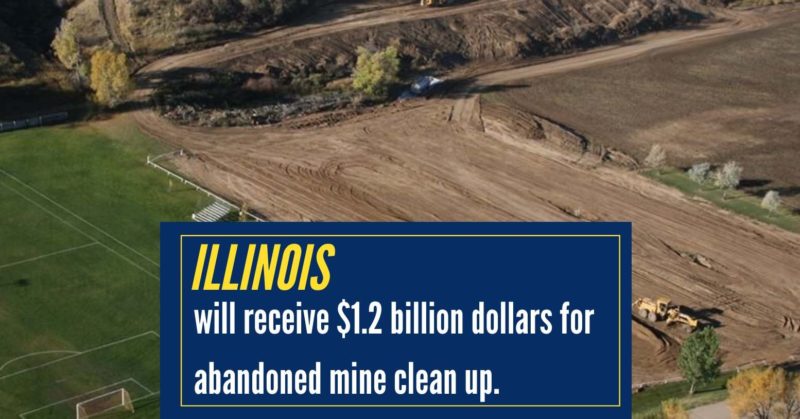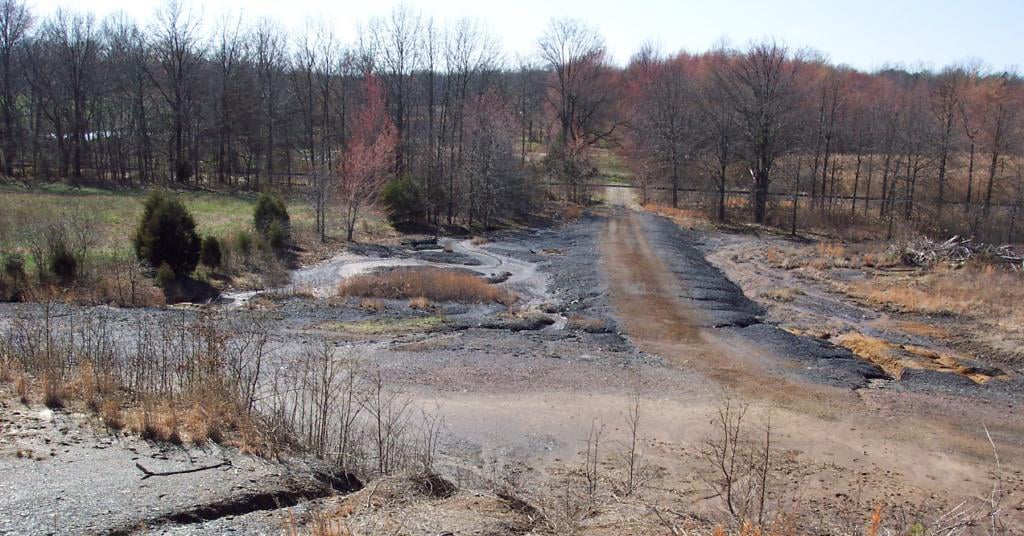By Amanda Pankau
The bipartisan Infrastructure Investment and Jobs Act is being called a “once-in-a-generation investment.” For the nation’s legacy of abandoned coal mine lands, and the communities and lands they impact, the Act means even more. The Act will reauthorize the recently expired funding mechanism (a per ton fee on mined coal) for the Abandoned Mine Land (AML) Reclamation Program trust fund and will also inject an additional $11.3 billion into the program over the next 15 years. It will put people to work restoring polluted lands and waters, and it will help build a new economic foundation in Illinois’ coal communities.
Today, Illinois remains the nation’s fourth largest coal producing state, and it has a long history of mining that touched 76 of Illinois’ 102 counties and left behind environmental, health, and safety problems. Earlier this fall, we put together a webinar to explore the past, present, and future of the Abandoned Mine Land reclamation program in Illinois. This blog explores that same topic, in addition to what the new federal funding means for Illinois.
History of Abandoned Mine Lands
Nearly two centuries of coal mining occurred in Illinois before the passage of any laws to regulate the operation or clean-up of the industry. By the late 1970s, over 200,000 acres of Illinois land had been affected by surface and underground mining. Nationwide that number was over a million acres. In response to the extensive environmental problems, as well as growing health and safety concerns, Congress passed the Surface Mining Control and Reclamation Act of 1977 (SMCRA).
SMCRA created two programs, one to regulate the operation and reclamation of new and active coal mines. The other to deal with lands that were mined and abandoned prior to the passage of the law. These unreclaimed lands that were mined prior to 1977 are defined legally as “abandoned mine lands,” and they are often also called “pre-law” mined lands or AML lands. In addition to impacts to the land, these sites include impacts to the water, the air, and public safety.
The AML program under SMCRA established a fee on coal production to fund the cleanup and reclamation of abandoned mine lands. The fee is collected by OSMRE on every ton of coal mined and then distributed to the states and tribes running AML programs. The future of the funding and national AML reclamation efforts had been in question after the collection of the fee expired this September.
AML Program in Illinois
The Illinois AML program is administered by the Illinois Department of Natural Resources (IDNR), Office of Mines and Minerals, Abandoned Mine Land Division. In the 40-year history of the AML program, Illinois has reclaimed 35,000 acres (GPRA equivalent acres*) at a cost of $433 million. An additional $25 million has been used toward projects that are in some state of active reclamation.
IDNR’s AML Division assesses abandoned mine lands throughout the state. When a problem area is identified it is inventoried according to eminent harm to public safety, environmental safety, etc. and ranked from high to low priority. Examples of common AML sites in need of reclamation in Illinois include unsealed mine openings, coarse and fine coal mine waste (known as gob and slurry, respectively), mine fires and gas leaks, dangerous highwalls, impoundments, and subsidence.
Exposed coal waste on many sites also contributes to a problem known as “acid mine drainage” (AMD) that can pollute water both onsite and downstream of AML areas. Acid mine drainage is the discharge of acid water from a mining site created by the oxidation of pyrite and sulfide minerals that were exposed during the mining process. Treatment of AMD in Illinois is a relatively new part of the state’s program, and the methods used often require ongoing maintenance over varying intensity.
The IDNR also oversees an AML Emergency Program** to address projects that arise suddenly and are life threatening or require immediate attention. The most common projects addressed by this program are pit subsidence and dangerous unsealed shaft openings.
Illinois’ AML sites are inventoried and mapped on the IDNR’s Illinois Coal Mine Permits Map***, an interactive map accessible to the public.
Future of the AML Program
The infrastructure bill is a lifeline to a severely underfunded program that had an uncertain future. In the four decades of the AML program, $7.9 billion worth of damage has been cleaned up nationwide, representing only ~25% of the total damage. While federal inventories estimate $11.0 billion in unreclaimed AML costs, a recent analysis by the Ohio River Valley Institute estimated an additional $20.9 billion needed to clean up all of the unreclaimed AMLs, as of 2020. The actual cost is estimated to be larger because the federal inventory reflects only construction costs, not design or administration costs, the federal inventory is outdated and not updated for inflation, and finally, the federal inventory does not include all of the unreclaimed AMLs in the field.
The $11.3 billion boost represents the largest-ever investment in AML clean-up, and it will create billions in economic activity and thousands of jobs in coal communities across 25 states and three tribes. It also reauthorizes the funding mechanism for the AML trust fund, a per-ton fee on current coal production, for 13 years at 80% of the prior level.

The bill will send an estimated $1.2 billion to Illinois over 15 years to clean up land polluted by coal mines that were abandoned before 1977. This funding is a substantial increase, providing Illinois future estimated annual allocations of funding at a rate seven times greater than its 2020 allocation. Additional program funding means additional abandoned mine land reclamation, in turn, providing communities with jobs to get the work done, cleaner water, and land that is ready for a new life. AML cleanup jobs extend beyond machinery operators. Government engineers, scientists, and managers design, administer, and research AML reclamation. Reclamation construction employs machinery operators but also clerical staff and tree planters.
Reinvestment in Energy Communities
Abandoned mine land reclamation to clean up the legacy of past pollution is just one important initiative to ensure a clean environment and resilient economic future for transitioning energy communities. This year we’ve seen action at the federal and state level to support reinvestment in energy communities. President Biden’s January executive order established an Interagency Working Group (IWG) on Coal and Power Plant Communities and Economic Revitalization. The group released a first report identifying priority communities and $38 billion in potentially available federal funding for these regions. Additional federal investments include the Economic Development Administration’s Coal Community Commitment that allocates $300 million of its $3 billion American Rescue Plan appropriation to support coal communities.
Illinois’ new Climate and Equitable Jobs Act includes support for transitioning fossil fuel communities and workers with the creation of the Energy Community Reinvestment Act that will invest millions in the communities hardest hit by the transition away from coal. The bill creates Energy Transition Community Grants, a Displaced Energy Worker Bill of Rights, and a Coal to Solar program that incentivizes renewable energy development and energy storage on the site of shuttered coal plants.
*GPRA is a standardized acre measurement calculated by federal officials in order to develop a common unit to compare problem types with different standard units (miles, feet, acre, etc.).
**In the event of an AML emergency, the IDNR AML staff can be reached at 618-650-3197 or 217-782-0588. If the situation requires immediate attention after business hours, contact the Illinois emergency Management Agency @ 800-782-7860.
***Mine Permit Viewer. In the upper right hand corner, select “Layer List”. Unselect “Permit Boundaries” and “Permitted Areas”. Select the “AML Project Site” layer to view reclaimed and unreclaimed identified AML sites in Illinois.








